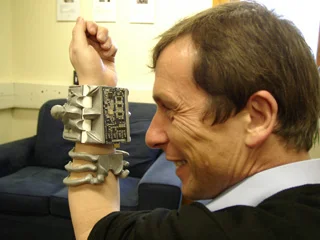Cyborgs
When I was at university I infrequently attended lectures put on a group called the Oxford Transhumanist Society. They would get in lecturers from different fields, but with a common theme of going past the current capabilities of humans in some way. Some talked about possible routes to preempting aging, others talked about cocktails of drugs for maximising concentration or the current state of brain mapping, with an eventual view to mind uploading. It was all very techno-optimistic and it spoke to the Science Fiction fan inside me.
In this article I'm going to focus on mechanical augmentation as the particular strain of transhumanism, in short cyborgs. The best lecture that the Society put on was one hosted by Dr Kevin Warwick who ran the Cybernetics Department at Reading University. Starting in 1998 Warwick had conducted a series of experiments on himself and he had had several surgeries to add technology to his body.
The first was to put an RFID (Radio Frequency Identification Device, like the chip in your Oyster Card) into his forearm. Given that this was almost 20 years ago, the chip was substantially bigger than the current models. In the labs and corridors of his Cybernetics department lights and doors were automated to detect his presence. Later, as these chips became more popular with his students they could be used as keys to open doors that you had permission to open.
Possibilities for this technology could be having them act as a debit card and, more morally ambiguously, as proof of ID. In his lecture Warwick suggested one useful role for them would be for people who have a serious medical condition, such as they are allergic to penicillin or they are diabetic, to voluntarily have an RFID in a standardised place which would be the first place paramedics would scan on arriving to an unconscious body. Again there are huge ethical considerations to come out of this.
That first experiment was just a proof of concept to see if the implant would be rejected by the body and whether the signal would reliably pass through the flesh to the receivers. The law was fuzzy on the issue of actually doing the surgeries and the University opted to use a body modification expert (and piercer, tattooist etc.) to carry the procedures out rather than a medical professional.
The much bigger leap forward came in 2002 when a piece of technology called a braingate was hooked up to the nerves in his left forearm. When Warwick moved his hand the sensor could measure the signals going through the arm and output them to a computer. It could also work the other way around by inputting signals which the brain would interpret as the hand being touched. After some time mapping which signals matched with which areas of the hand and with which movement. They had an artist design the look of the piece to look properly cyborg, which I appreciate.
Warwick with his braingate augmentation
One experiment involved Warwick and a robotic hand on different sides of the Atlantic. The hand had several degrees of freedom and had pressure sensors built into the fingertips. When Warwick moved his hand the signal would travel from brain, to arm, to the augmentation, to the computer, over the internet and finally into the robotic hand which would move in the same way. When the hand touched something the signals would travel the other way and Warwick's brain would interpret it as a touch sensation in his own hand.
In a sense the robotic hand was part of him, it just happened to be separated by a huge distance. We are still a long way off building full doubles for humans that we could live through like in the Bruce Willis film Surrogates, but for simpler remote control which requires pressure feedback for dexterity this is a massive step forwards.
He had the arm for 3 months while they perform various tests on it. In one experiment his wife was hooked up to a more temporary version of the braingate and they were sat back to back in a room. When one of them moved their arm the other would feel it in their arm. Crazy.
One of the more popular areas of cyborg enhancement is add on senses. For example some people have magnets placed into their fingertips so that they can feel electromagnetic waves. You could feel as your computer turned on from a distance for example. If you stuck some other sort of sensor onto your finger, for instance infrared or sound, then you could have the device detect and convert that wave into an electromagnetic wave. For instance you could point at something and get its temperature from across the room which you would feel as an electromagnetic wave moving in your fingertip. Or you could feel music. There was an AMA on reddit with a student who had a magnet implanted and he confessed that while all of the other applications were interesting he mostly just used it for bar tricks.
One add of sense I really like the idea of is called a Northpaw. It is an ankle bracelet with a ring of 8 vibrating motors arranged in a ring. At all times the one which is closest to north is subtly vibrating, so without having to think about it you will always know which way north is. After wearing them for a few weeks users described taking them off as akin to losing one of their other senses. There a few individuals that have implanted the equivalents of Northpaws into their knee surgically.
Finally, I can't mention cyborgs and not bring up this guy:
Neil Harbisson
Neil Harbisson is an artist who was born with a very severe form of colourblindness called achromatopsia where everything he sees is in grey-scale. In 2004 he had an antenna surgically attached to his skull which he calls an eye-borg. It sees colours, processes them and outputs them as sounds into his inner ear. All of his work is based on vibrant colours which he can only perceive as different musical notes. He has replaced what was a disability with technology. His TED talk is well worth a watch and in it he revealed he can hear infrared and UV as well as the normal range of colours.
Harbisson is also a big advocate for cyborg rights. In 2004 he had a huge argument with the passport office over their laws about having technology in a passport photo. He managed to get them to allow technology which is part of the body of a human. Where this becomes fuzzy is on the borderline; is wearable technology like the Google Glass not similar, even if it doesn't happen to be physically attached?
Another big name in cyborg rights is Steve Mann. He has been wearing computers on his face for the last 20 years which give him overlays over his vision with emails, calendars and so on. He also has cameras inbuilt to record his life. In 2012 there was the first reported targeted attack on a cyborg when three employees of a McDonald's in Paris attacked Steve Mann when he was trying to have a meal with his family. He was wearing one of his more strapped on setups and they tried to rip it off his face to stop him recording. I think it brings up interesting ethical questions of consent for surveillance in a world where wearable cameras are becoming more common.
Steve Mass in one of his more lightweight wearable computers
I'll finish this article with a quick talk on the biggest group of cyborgs; people who use prosthetics for limb replacement. I can't find any example where someone has voluntarily amputated a completely healthy limb yet, but some of the bionic legs that have been developed over recent years are starting to become better than our biological ones. They can be made in a modular fashion and so can be switched out for the perfect tool for any situation. Most people are familiar with how fast paralympian sprinters are with their blades, with times almost as fast as Usain Bolt. In a similar way, if you want to rock climb then having legs like this would be more appropriate for the situation than something trying to imitate a human foot:
Hugh Herr rockclimbing
This is Hugh Herr, a designer of prosphetic legs and avid mountain climbing (he lost his lower legs to frostbite). He has different legs for different scenarios and his ones for everyday wear allow him to walk completely naturally including on rough terrain or when running up and down stairs. Add on the fact that you can put in external power sources so that you can have the limb provide more strength than you would have normally and you have something which is starting to come out of the category of disability and into the region of superhuman. Instead of aging and weakening like the rest of your body a robotic arm or leg will improve as technology improves and can be replaced if it breaks.
Hugh Herr's everyday legs











